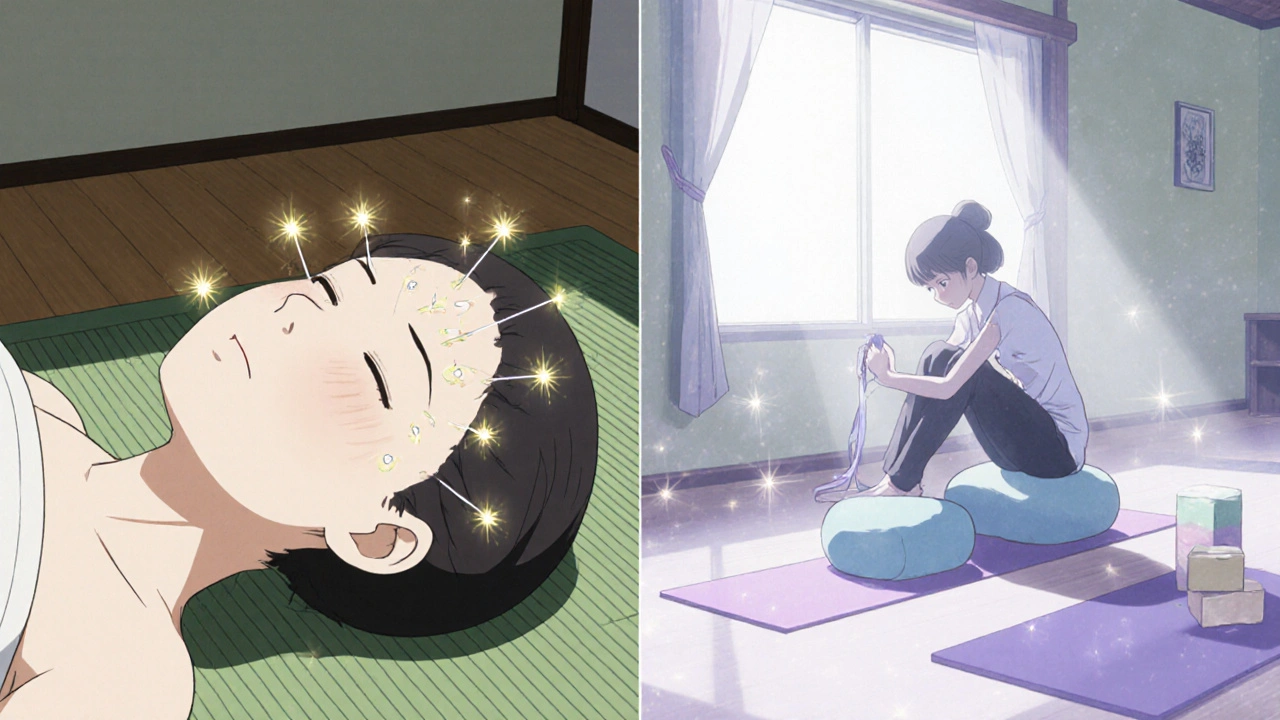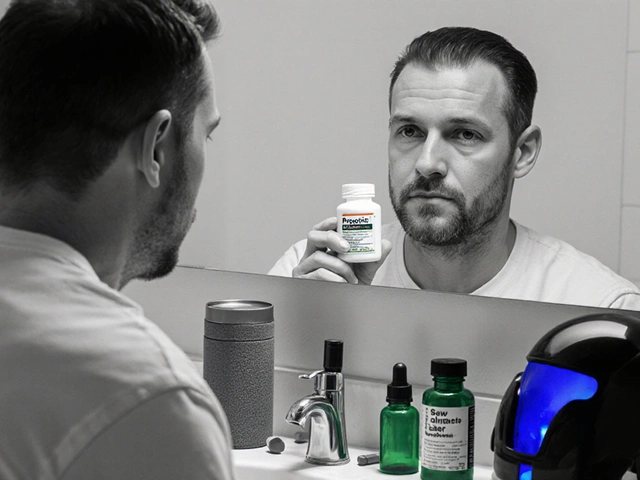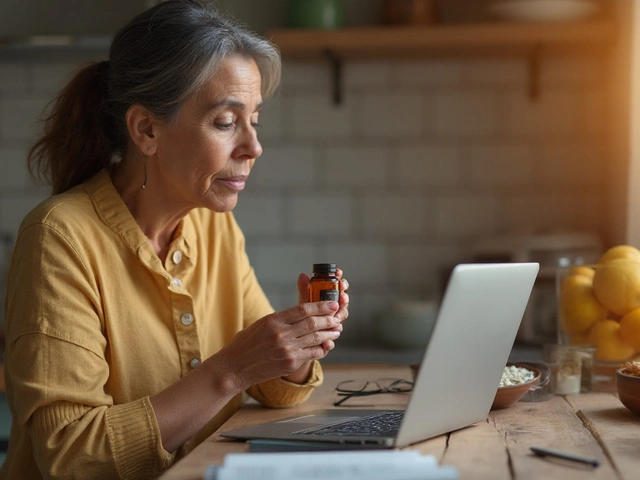Lupus Therapy Safety Checker
This tool helps identify complementary therapies that are likely safe based on your medications and current health status. Always consult your rheumatologist before starting any new therapy.
Your Current Medications
Your Symptoms & Conditions
Results will appear here after checking your input.
Living with Lupus often means juggling prescription meds, flare‑ups, and doctor visits. While conventional treatments target inflammation and immune suppression, many patients look for extra tools to ease symptoms, boost energy, and improve quality of life. This guide walks you through the most researched alternative and complementary options, how to pick the right ones, and safety tips to keep your care plan balanced.
Why Add Alternative or Complementary Therapies?
Standard lupus therapy-think hydroxychloroquine, steroids, or biologics-does a solid job of controlling severe organ involvement. Yet they don’t always resolve fatigue, joint stiffness, or the emotional toll of a chronic illness. Adding evidence‑backed, low‑risk approaches can:
- Reduce stress, a known trigger for flares.
- Support joint mobility and muscle strength.
- Improve sleep quality and overall mood.
- Provide nutritional support that may complement medication.
Remember, "alternative" doesn’t mean "replace" your doctor’s prescription. Think of these options as add‑ons that work lupus patients often find helpful.
Core Categories of Therapies
Below are the main groups that have shown promise in clinical trials or large observational studies.
- Acupuncture
- Yoga and Tai Chi
- Massage therapy
- Dietary patterns (Mediterranean diet, anti‑inflammatory foods)
- Targeted supplements (Omega‑3 fatty acids, Vitamin D, Turmeric/curcumin)
- Mind‑body practices (guided meditation, progressive muscle relaxation)
Acupuncture
Acupuncture involves inserting thin needles at specific points to modulate pain pathways and immune signaling. A 2022 systematic review of 12 randomized trials found modest reductions in pain scores and fatigue for lupus patients compared with sham acupuncture.
- Typical regimen: 1‑2 sessions per week for 6‑8 weeks, then maintenance as needed.
- Safety: Minimal; watch for bruising or infection if needles aren’t sterilized.
- Where to start: Choose a licensed practitioner experienced with autoimmune conditions.
Yoga and Tai Chi
Both practices combine gentle movement, breathing, and meditation, which can lower cortisol and improve joint flexibility. In a 2021 cohort of 120 lupus patients, those who practiced yoga twice weekly reported a 30% drop in fatigue and a 20% improvement in quality‑of‑life scores.
- Style tips: Look for “Therapeutic Yoga” or “Medical Tai Chi” classes that avoid deep twists.
- Frequency: 30‑45 minutes, 2‑3 times per week.
- Safety: Use props (blocks, straps) and listen to your body; avoid poses that strain the neck or spine if you have organ involvement.

Massage Therapy
Therapeutic massage can ease muscle tension, improve circulation, and promote relaxation. A small RCT in 2020 showed that weekly 60‑minute Swedish massage reduced joint pain VAS scores by 1.5 points versus usual care.
- Best type: Swedish or myofascial release; avoid deep tissue if you have skin rashes or active vasculitis.
- Session length: 45‑60 minutes, once weekly.
- Precautions: Confirm with your rheumatologist that massage won’t interfere with any IV lines or recent injections.
Dietary Changes
While no single “lupus diet” exists, patterns rich in anti‑inflammatory foods consistently correlate with fewer flares.
- Mediterranean diet: Emphasizes olive oil, fatty fish, nuts, vegetables, and whole grains. A 2023 meta‑analysis linked this diet to a 15% reduction in disease activity scores.
- Limit: Processed sugars, high‑sodium foods, and excess red meat, which can worsen inflammation.
- Practical tip: Aim for at least two servings of omega‑3‑rich fish (salmon, sardines) per week.
Targeted Supplements
Supplements can fill nutritional gaps, but they should be chosen carefully.
| Supplement | Evidence Level | Typical Dose | Main Benefit |
|---|---|---|---|
| Omega‑3 fatty acids | Moderate | 1‑2 g EPA/DHA daily | Reduces joint pain & cardiovascular risk |
| Vitamin D | Strong | 800‑2000 IU daily (or per blood level) | Supports bone health & immune modulation |
| Turmeric/curcumin | Low‑to‑moderate | 500‑1000 mg with black‑pepper extract | Anti‑inflammatory, may lower fatigue |
Always test levels before starting Vitamin D and discuss any supplement with your doctor to avoid drug interactions.
Mind‑Body Practices
Stress is a major flare trigger. Techniques like guided meditation, progressive muscle relaxation, or even simple breathing exercises can lower cortisol within weeks.
- App suggestion: Headspace or Insight Timer-both offer 10‑minute sessions suitable for beginners.
- Routine: Practice 5‑10 minutes each morning and before bedtime.
- Outcome: Studies show a 20% reduction in self‑reported stress scores after 8 weeks of regular practice.
How to Choose Safe Therapies
Not every trendy remedy fits every lupus case. Follow this checklist before adding any new modality.
- Consult your rheumatologist-share any therapy you plan to try.
- Check the evidence: look for peer‑reviewed studies or reputable health organization guidelines.
- Verify practitioner credentials (licensed acupuncturist, certified yoga therapist, etc.).
- Start slow: introduce one new practice at a time and monitor symptoms for 2‑4 weeks.
- Watch for interactions: some herbs (e.g., St. John’s wort) can affect drug metabolism.
Sample Weekly Routine
Here’s a realistic plan that blends three high‑impact therapies with daily habits.
- Monday & Thursday: 45‑minute therapeutic yoga class (focus on gentle flows).
- Tuesday: 30‑minute guided meditation before work.
- Wednesday: Acupuncture session (1 hour).
- Friday: 60‑minute Swedish massage.
- Daily: Mediterranean meals, 2 servings of fatty fish weekly, Omega‑3 supplement, Vitamin D as prescribed, and 10‑minute evening breathing exercise.
Track your energy, pain, and mood in a simple diary; adjust the schedule based on what feels best.
Potential Risks & Red Flags
Even low‑risk therapies can cause issues if misapplied.
- Infection risk: Acupuncture needles must be single‑use; avoid if you’re immunosuppressed with a low white‑blood‑cell count.
- Skin sensitivity: Massage may aggravate rashes or vasculitic lesions-skip affected areas.
- Supplement overload: Too much Vitamin D can cause hypercalcemia; high Omega‑3 can affect clotting if you’re on anticoagulants.
- Flare triggers: Overexertion in yoga or Tai Chi can temporarily increase joint pain-listen to your body.
If you notice new symptoms (fever, worsening rash, sudden joint swelling) after starting a therapy, pause it and contact your healthcare team.
Frequently Asked Questions
Can I replace my prescription meds with alternative therapies?
No. Alternative and complementary approaches are meant to support, not replace, disease‑modifying drugs. Stopping medication without a doctor’s guidance can lead to serious organ damage.
How long does it take to see benefits from yoga?
Most people notice reduced stiffness and better sleep after 4‑6 weeks of consistent practice, though individual results vary.
Is acupuncture safe for someone on blood thinners?
Generally yes, but choose a practitioner who knows your medication history. Some clinicians recommend fewer needles and avoiding points near major vessels.
What dosage of Vitamin D is recommended for lupus patients?
Dosage depends on blood levels. Many specialists aim for 30‑60 ng/mL serum 25‑OH vitamin D, which often means 800‑2000 IU daily, but testing is essential.
Can I do massage if I have a skin rash?
Skip areas with active rash or vasculitis. Light, non‑oil‑based techniques on unaffected skin are usually fine.
Integrating alternative and complementary therapies can empower you to manage lupus more holistically. By staying informed, collaborating with your care team, and listening to your body, you’ll find a personalized mix that reduces flares, eases daily fatigue, and improves overall well‑being.







8 Comments
When I first read this guide I felt like I was handed a secret weapon against lupus, a beacon of hope amidst the endless medication maze.
The sheer breadth of options-from acupuncture needles dancing under skin to the gentle hum of yoga breathing-makes my brain explode with possibilities.
Imagine waking up without that crushing fatigue, stepping out of bed feeling like you could actually chase the sunrise instead of dragging your feet.
Acupuncture, once dismissed as mystic mumbo‑jumbo, now boasts real data that cuts pain like a laser.
Sure, the needles prick a little, but think of the reward: a modest dip in those dreaded VAS scores.
And yoga? Oh, the way it coaxed my stiff joints into not screaming every time I reached for a cup of tea was nothing short of miraculous.
The guide even drops the holy grail of omega‑3s, those little fishy capsules that whisper promises of smoother arteries and calmer joints.
I cannot stress enough the importance of checking vitamin D levels; a deficiency can turn the whole house into a winter of discontent.
But remember, none of this replaces your doctor’s prescription, it merely adds flavor to the stew of treatment.
The sample weekly routine reads like a playlist for a healthier life, and I’m ready to hit play.
If you ever doubted the power of a Mediterranean diet, just picture plates full of olive oil, nuts, and bright veggies doing a tango on your taste buds.
Avoid the sugary traps, those sneaky culprits that inflame more than just your waistline.
Even the most timid of us can start with five minutes of guided meditation before bed and feel the stress melt away.
Track your progress like a detective, noting pain, mood, and energy, because data never lies.
In the end, this guide is not just a list; it’s a roadmap, a battle plan, a rallying cry for anyone refusing to let lupus dictate the terms.
Honestly, the whole hype around yoga and tai chi is overrated. If you’re looking for measurable outcomes, stick to proven meds and maybe a pinch of omega‑3. Don't get sucked into the wellness fad circus; it distracts from real disease management. The guide glosses over that, and that needs calling out.
Wow, another supplement list that pretends to be backed by science while ignoring the massive conflicts of interest. Vitamin D dosage? Sure, just throw in 2000 IU and hope for the best, because who needs blood tests? And turmeric, the darling of Instagram influencers, barely moves the needle on fatigue. Keep your eyes peeled for those hidden pharma sponsorships lurking in the footnotes.
Acupuncture isn’t some mystical portal; it’s a needle‑based stimulus that can modulate the nervous system. Studies show modest pain relief, but the effect size is often comparable to a placebo with a fancy setting. Choose a licensed practitioner, verify sterile technique, and don’t expect miracles after a single session. Consistency is key, and even then you’ll likely need to pair it with standard therapy.
Life is a tapestry woven with threads of pain and hope, and each alternative therapy is a hue on that loom. The choice between massage and meditation mirrors the ancient dichotomy of body and soul, yet both converge in the river of wellbeing. One must not chase the glitter of quick fixes, but rather walk the slow garden path of consistent care. In the end, the universe favors those who listen to their inner compass, even when the compass points toward the unexpected.
Let me tell you, the Mediterranean diet isn’t just a fad-it's practically a national treasure that outshines any processed junk exported from the West. Olive oil, fresh fish, and vibrant vegetables are the true defenders of our health, beating out those bland American fast‑food meals any day. If you want real anti‑inflammatory power, ditch the sugary soda and embrace the ancient wisdom of the Mediterranean table. This guide finally gives those proven foods the spotlight they deserve, and that’s something to celebrate.
Stick to evidence‑based treatments. Supplements without labs are risky. Follow the checklist, monitor labs, and adjust only under physician guidance.
Ever wonder why pharma pushes steroids while quietly downplaying low‑risk options? It's no coincidence that the biggest profit margins sit with high‑dose meds, not with calming yoga classes. The guide hints at alternatives, but the real story is hidden behind a veil of corporate interest. Keep your eyes open; the truth often lies in what's left unsaid.
Write a comment